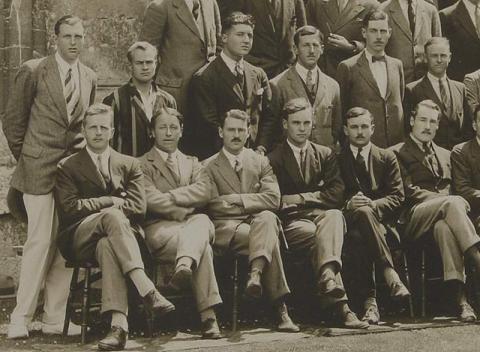Humphrey was the second of the four sons of Arthur Herman Gilkes and his wife, Millicent Mary Clarke. He had one sister.
Arthur Herman Gilkes was a renowned Master of Dulwich College where all his sons were educated, as well as the three brothers of his wife and where his son, Christopher held the same position, some years later. He had graduated from Christ Church in 1872 with a First Class Honours Degree in Literae Humaniores. After retiring from Dulwich in 1914, he was ordained and was Vicar of St Mary Magdalen’s Church, Oxford from 1917 until his death in 1922.

Whilst at Dulwich College, Humphrey played in the First X1 in 1910. He was a violinist of distinction and proud of his Gilkes Violin which had been made by a forbear. He was awarded the Alleyn Club Prize for Music [Orchestra} in 1914.
The Prize was a copy of Sir George Grove’s “Beethoven & his Symphonies”
[It was offered for sale on the internet on a Spanish website in 2011
Novello and Co., Limited, London, 1896. Full calf. Estado de conservación: Very Good. 2nd ed. 8vo. pp.viii, 407; endpapers marbled; aeg. Preface dated 1896. Spine has five raised bands, with gilt title etc. Two loose pages reinserted and glued in place. The covers gilt ruled with Dulwich College coat of arms at centre of front cover. Alleyn Club Prize copy from Dulwich College to H. A Gilkes, for Music (Orchestra), signed by A. H. Gilkes, dated in hand July 1914. Gilkes, the most highly regarded of the Masters of Dulwich College in the nineteenth century, promoted music at the College. The author of the book, Sir George Grove, had earlier advised the music master of the school, Edward Randall, to employ Arnold Dolmetsch as violin teacher there]
On leaving Dulwich, he joined the London Regiment and served with the 47th [London] Division throughout the war.
On 17 September 1917, the London Gazette announced the award of the Military Cross "For conspicuous gallantry and devotion to duty as Battalion Intelligence and Signalling Officer. He made repeated reconnaissances under heavy fire, gaining valuable information and maintaining efficient communications throughout a period of several days”

On 4 March 1918, he was awarded a Bar to his Military Cross. “For conspicuous gallantry and devotion to duty. He led a patrol to a strong point 500 yards in advance of our line to discover whether it was occupied by the enemy. Finding it unoccupied, he set fire to the dugout and blew up a store of bombs and ammunition. He showed great resource and initiative”.
A second Bar was gazetted on 22 June 1918 " For conspicuous gallantry and devotion to duty. Accompanied by an NCO, he entered the enemy's advanced line and captured four prisoners. On the following day, he reconnoitred the ground in advance of the line for over 1,500 yards, and discovered the enemy's dispositions. Later he reconnoitred over 2,000 yards of the front and obtained valuable information as to the enemy’s movements. On the same day, when the situation was very obscure, he entered a village which was held by the enemy, reconnoitred it, and brought back valuable information. He showed magnificent daring and skill."
A third Bar was gazetted on 1 February 1919 "For conspicuous gallantry at Moislains on September 2nd 1918. When an attack had partially failed, and the situation had become obscure, he made repeated reconnaissances through a very heavy barrage, and over ground swept by machine-gun fire, regardless of his own safety, and it was owing to his accurate reports that timely action was taken to restore a critical situation. His courage and resource was most marked."
During World War I, Acting Captain Francis Victor Wallington of the Royal Field Artillery was the first person to be awarded the MC and three bars when he was invested with his third bar on 10 July 1918 (gazetted 13 September 1918: he had obtained the first three awards as a second lieutenant). Three other officers were subsequently awarded a third bar, Percy Bentley, Humphrey Arthur Gilkes and Charles Gordon Timms, all of whose awards were gazetted in a supplement to the London Gazette of 31 January 1919.
From the History of the 47th {London] Division 1914-1919 March 22/23 1918,
“Communications had become worse, as we were getting off the front network of telephone lines, and much had to be done by means of runner and despatch-rider. During the day much visual signalling had been done, the 140th Brigade keeping up communication all day with the Metz exchange by this means. The 15th Battalion, on the extreme right, had an anxious and heavy task to perform, and the fact that no Germans filtered through the gap throws great credit on the way in which the patrols and machine-gunners did their work that night. One of the officers attached to the 140th Brigade Headquarters (Lieutenant H. A. Gilkes, M.C.) went out alone to Dessart Wood and brought in two German prisoners, a piece of work typical of this gallant young officer, who won the rare distinction of three bars to his Military Cross.
Humphrey Matriculated in 1919 and came up to Christ Church to read Medicine. He played cricket for the College. He went on to train at St. Bartholomew’s Hospital.
[M.A., M.D., B.Ch.(Oxon.), D.P.H., D.T.M. and H.(Lond.).]
Having resigned his commission in 1923, he joined the Colonial Medical Service. After serving in Northern Rhodesia, he moved for a number of years to Trinidad as Director of Medical Services.
With the outbreak of the Second World War, at the rank of Colonel, he joined the RAMC and served in Somaliland as Principal Medical Officer.
He was killed in an air crash on 11 July 1945 and is one of 13 Commonwealth members buried in Djibouti New European Cemetery. Coll. grave 184-190.
He is commemorated at Dulwich College by the Colonel H A Gilkes Prize for Physics.

